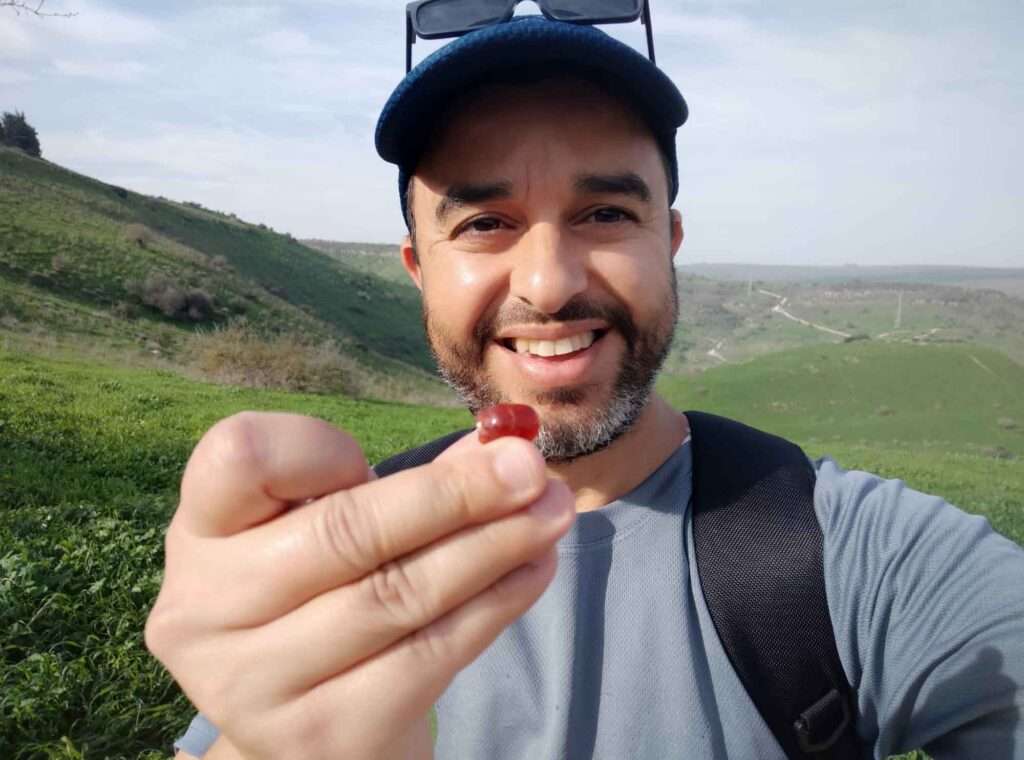An Israeli soldier who went for a hike in the rain while taking a two-day break from the army discovered an almost 3,000-year-old scarab beetle carved into a precious stone and has been given a thank-you certificate in return for the priceless find.
Erez Avrahamov, 45, from Padoel, in Israel, was on a hike at the Tabor Stream Nature Reserve in the Lower Galilee in Israel while on leave from the Israel Defense Forces when he made the incredible discovery, according to local media.
Newsflash obtained a statement from the Israel Antiquities Authority (IAA) saying: “The seal may indicate the presence of Assyrian (or perhaps Babylonian) officials in the area nearly 2,800 years ago.
“The rare find was transferred to the national treasures department of the Israel Antiquities Authority, and the hiker received a certificate of appreciation.”

Avrahamov said: “I had a two-day leave from the military and decided to take advantage of the sunny days for a trip. During the trip, I saw something sparkling on the ground.
“At first, I thought it was a bead or an orange stone. After picking it up, I noticed engravings on it resembling a scarab. I contacted and reported the amazing find to the Israel Antiquities Authority.”
And Nir Distelfeld of the Theft Prevention Unit at the Israel Antiquities Authority said: “I received a call from Erez, and I understood that he found something special.
“I told him to look closely at the other side – the flat side of the scarab he found – and check if it was engraved. Immediately I heard an exclamation of amazement over the phone, and he reported to me that he identified a figure.”
Professor Emeritus Othmar Keel of the University of Fribourg in Switzerland said: “The scarab, made of a semi-precious stone called carnelian, depicts a griffin (a mythical creature) or a winged horse galloping. Similar scarabs were dated to the 8th century BC.”
Distelfeld said: “We thank Erez, who showed good citizenship and delivered the rare scarab to the national treasures of the Israel Antiquities Authority.

“We awarded him a certificate on behalf of the Israel Antiquities Authority for demonstrating exemplary citizenship. Such a rare find can certainly expand our knowledge of the past.”
Distelfeld said that “the beautiful scarab was found at the foot of Tel Rekhesh, one of the important tel sites in the north of the country. The site is identified as the city of ‘Anacharath’ (Joshua 19:19) within the territory of the tribe of Issachar.”
Dr Yitzhak Paz, an archaeologist at the Israel Antiquities Authority who has been excavating at Tel Rekhesh since 2006, explained: “One of the most important periods of settlement dates back to the Iron Age (6-7th centuries BC).
“During this period, a large citadel stood atop the mound containing fortified structures, paved bathrooms, halls and ceremonial chambers which belonged to the Assyrian rule. This rule was responsible for the destruction of the Kingdom of Israel. The scarab discovered at Tel Rekhesh may be from the period of the Assyrian rule and may indicate the presence of Assyrian officials (or perhaps Babylonian) at Tel Rekhesh during this period.
“The griffin appearing on the seal is a known artistic motif in Ancient Near Eastern art and is common on seals from the Iron Age. Considering the scarcity of finds discovered so far area of the citadel, and if indeed the seal can be dated to the late Iron Age based on iconographic considerations, it may be possible to link the seal to the Assyrian presence in the citadel of Tel Rekhesh, which may be a discovery of great significance!”
The statement said: “The scarab is a type of seal that was common throughout the region from the 4th millennium BC onwards. Scarab seals were designed in the shape of a beetle, hence -their name.

“The Egyptian name is derived from the verb ‘to be created’ or ‘to be born’ because the Egyptians saw the scarab as a symbol of the creator god.”
Eli Escusido, the Director of the Israeli Antiquities Authority, said: “Every winter, with the arrival of the rainy season, antiquities begin to ‘float’ and rise above the surface.
“I urge the public to adhere to the Antiquities Law and ask that if you come across an archaeological find, report it to the Israel Antiquities Authority immediately from the site.”
To find out more about the author, editor or agency that supplied this story – please click below.
Story By: Joseph Golder, Sub-Editor: Joseph Golder, Agency: Newsflash
The Ananova page is created by and dedicated to professional, independent freelance journalists. It is a place for us to showcase our work. When our news is sold to our media partners, we will include the link here.




